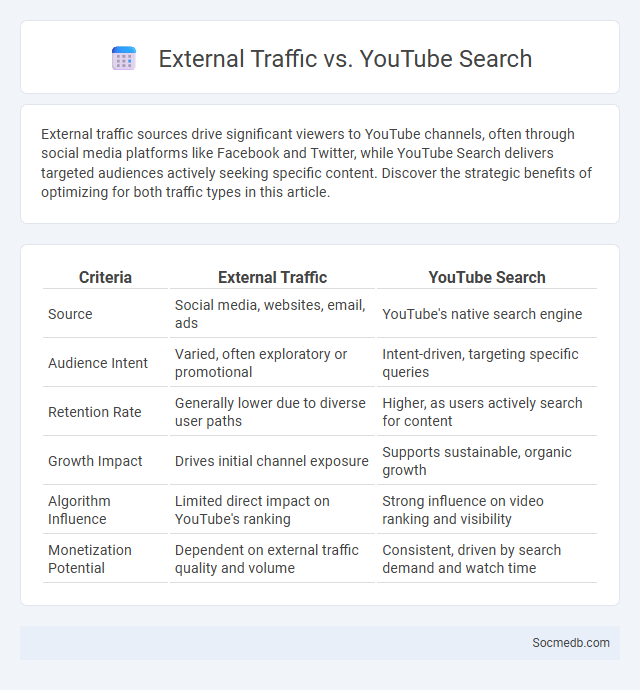
Photo illustration: External Traffic vs YouTube Search
External traffic sources drive significant viewers to YouTube channels, often through social media platforms like Facebook and Twitter, while YouTube Search delivers targeted audiences actively seeking specific content. Discover the strategic benefits of optimizing for both traffic types in this article.
Table of Comparison
| Criteria | External Traffic | YouTube Search |
|---|---|---|
| Source | Social media, websites, email, ads | YouTube's native search engine |
| Audience Intent | Varied, often exploratory or promotional | Intent-driven, targeting specific queries |
| Retention Rate | Generally lower due to diverse user paths | Higher, as users actively search for content |
| Growth Impact | Drives initial channel exposure | Supports sustainable, organic growth |
| Algorithm Influence | Limited direct impact on YouTube's ranking | Strong influence on video ranking and visibility |
| Monetization Potential | Dependent on external traffic quality and volume | Consistent, driven by search demand and watch time |
Understanding YouTube Traffic Sources
Understanding YouTube traffic sources is crucial for optimizing your channel's growth and viewer engagement. Traffic comes primarily from sources like YouTube search, suggested videos, external websites, and direct URL sharing, each contributing to how viewers discover your content. By analyzing traffic data in YouTube Analytics, you can tailor your content strategy to boost visibility through the most effective channels impacting your audience reach.
What is External Traffic?
External traffic refers to visitors who arrive at a social media page or website from sources outside the platform itself, such as search engines, other websites, or email campaigns. This type of traffic is crucial for expanding audience reach beyond organic social media followers, driving diverse and engaged users to content. Analyzing external traffic sources helps marketers optimize campaigns by targeting channels that bring the highest quality visitors and increase conversions.
Overview of YouTube Search Traffic
YouTube search traffic drives a significant portion of video views, as users actively seek content using specific keywords and phrases. Optimizing your videos with targeted titles, descriptions, and tags enhances visibility in YouTube's search algorithm, increasing organic reach. Leveraging this traffic source can significantly boost your channel's growth and audience engagement.
Exploring the YouTube Analytics Dashboard
The YouTube Analytics Dashboard offers comprehensive insights into your channel's performance, revealing key metrics such as watch time, viewer demographics, and traffic sources. By understanding data on audience retention and engagement rates, you can tailor your content strategy to maximize growth and reach. You gain the ability to optimize your videos' effectiveness, boosting visibility and subscriber interaction through data-driven decisions.
Key Differences: External Traffic vs YouTube Search
External traffic sources drive viewers to YouTube videos through links on social media platforms, websites, or email campaigns, leveraging diverse audiences beyond YouTube itself. YouTube search traffic originates from users actively searching on YouTube using keywords, highlighting the importance of video SEO, optimized titles, descriptions, and tags. Understanding these distinctions enables creators to tailor strategies: external traffic campaigns boost visibility through cross-platform promotion, while YouTube search traffic relies on algorithm-driven discoverability.
The Role of Referral Sites in External Traffic
Referral sites play a critical role in driving external traffic to social media platforms by directing users from blogs, news sites, and online forums. High-authority referral sources such as popular news websites and influencer blogs can significantly boost visibility and engagement metrics. Leveraging referral traffic enhances social media reach, increases user acquisition, and improves overall platform SEO rankings.
How YouTube Search Impacts Video Discovery
YouTube search plays a crucial role in video discovery by leveraging keywords, metadata, and user engagement to rank relevant content higher in search results. The platform's powerful algorithm analyzes video titles, descriptions, tags, and watch history to personalize recommendations that increase visibility and viewer retention. Optimizing video content for YouTube search enhances organic reach, driving more traffic and subscriber growth.
Leveraging Analytics Dashboard for Data Insights
Leveraging analytics dashboards in social media enables businesses to extract actionable data insights from user engagement, content performance, and audience demographics. These dashboards consolidate metrics such as reach, impressions, click-through rates, and conversion rates into intuitive visual reports, facilitating informed decision-making for optimizing marketing strategies. Real-time data monitoring via analytics tools enhances the ability to quickly adapt campaigns to shifting trends and maximize return on investment.
Optimizing Content Strategy for Each Traffic Source
Optimizing content strategy for each social media traffic source requires analyzing audience behavior and platform algorithms to tailor content that maximizes engagement and conversion rates. Facebook benefits from visually rich posts and community-driven content, while Instagram prioritizes high-quality images and stories that drive brand visibility and interaction. LinkedIn demands professional, educational content that establishes authority, and Twitter excels with timely, concise updates and trending hashtags to boost reach and real-time engagement.
Measuring Success: Metrics That Matter
Measuring the success of your social media efforts relies heavily on key metrics such as engagement rate, reach, and conversion rate. Tracking these metrics provides insight into audience interaction and the effectiveness of your content strategy. Analyzing data from platforms like Instagram, Facebook, and Twitter helps you refine campaigns to maximize impact and achieve your marketing goals.
 socmedb.com
socmedb.com